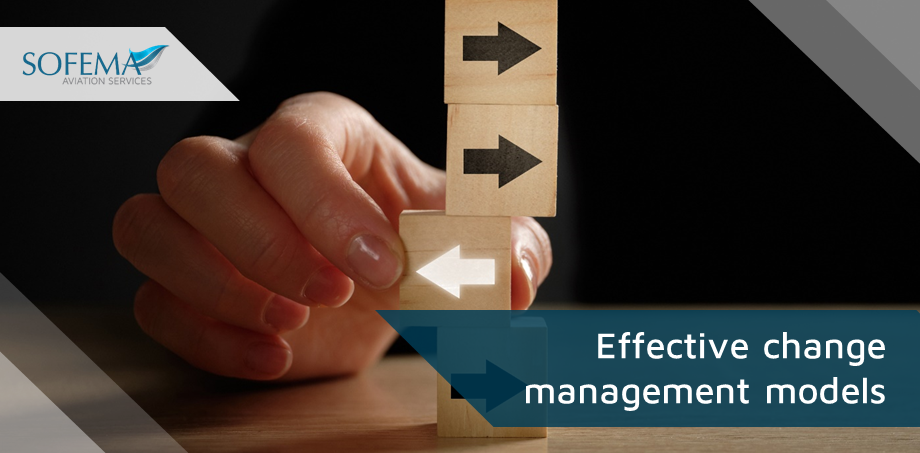Sofema Aviation Services (SAS) www.sassofia.com takes a deep dive into effective change management models and considers the most appropriate for different scenarios
Introduction
Selecting the appropriate aviation change management model/framework for different situations requires understanding the specific challenges and needs of each scenario.
- The aviation industry is complex, with various stakeholders, regulations, and safety requirements.
- Selecting the appropriate change management model or framework for different situations is essential to ensure the successful implementation and adoption of new practices or technologies.
- Careful consideration and analysis of the situation are essential to ensure the successful implementation of change in this critical industry.
- When choosing a change management model, it is essential to consider
The complexity of the situation
o The organization’s culture
o The resources available
o The desired outcomes.
o Adapt and customize the chosen model to fit your specific situation and requirements, ensuring a successful implementation of the change.
1) Lewin’s Change Management Model
. It is ideal for situations where changes are relatively simple and can be quickly implemented, such as updating internal procedures or implementing new technology for routine operations. Where the need for change is clearly understood, and the transition can be achieved in a straightforward manner.
- Situation: Implementing a small-scale change or addressing cultural or behavioural issues.
- Three stages: Unfreeze (preparing for a change), Change (implementing the change), and Refreeze (solidifying the change).
- Use when: Resistance to change is expected, or a focus on changing people’s attitudes and behaviours is necessary.
2) ADKAR Model:
It is suitable for situations where the change primarily impacts employees’ roles, behaviours, or skills.
Introducing a new customer service training program to improve the quality of service provided by airline staff. This change requires employees to develop new skills and behaviours to enhance customer experience.
- Situation: Addressing change at the individual level, improving employee engagement, or overcoming resistance.
- Five components: Awareness, Desire, Knowledge, Ability, and Reinforcement.
- Use when: Change requires effective communication, personal motivation, and skill development.
3) Kotter’s 8-Step Change Model:
This model is well-suited for complex, large-scale changes in the aviation industry, such as mergers, acquisitions, or complete organizational overhauls. Kotter’s model outlines eight steps that guide organizations through the change process, focusing on creating a sense of urgency, forming a guiding coalition, developing a clear vision, communicating the vision, removing obstacles, generating short-term wins, building on the change, and anchoring the change in the organization’s culture.
Example – Implementing a new safety management system across an airline or an entire airport, which requires a comprehensive understanding of the current processes, the identification of potential risks, and the development of new risk mitigation strategies.
- Situation: Implementing large-scale organizational change, addressing complex issues, or when significant stakeholder buy-in is necessary.
- Eight steps: Establish a sense of urgency, create a guiding coalition, develop a vision and strategy, communicate the change vision, empower broad-based action, generate short-term wins, consolidate gains and produce more change, and anchor new approaches in the culture.
- Use when: The change process requires a structured approach and clear communication.
4) McKinsey 7S Framework:
The McKinsey 7S Model is ideal for situations that require a holistic approach to change management, such as implementing new technology systems or restructuring departments. This model emphasizes the interconnectedness of seven organizational elements (strategy, structure, systems, shared values, style, staff, and skills) and the need to align them for successful change.
- Situation: Addressing organizational alignment, adapting to internal or external changes, or improving efficiency.
- Seven components: Strategy, Structure, Systems, Shared Values, Skills, Style, and Staff.
- Use when: Change requires a holistic view of the organization, addressing various aspects, and ensuring alignment.
5) Bridges’ Transition Model:
This model focuses on the psychological transition that individuals go through during change, making it appropriate for changes that have a significant impact on employees, such as layoffs, role changes, or new management. The model highlights three stages: ending (letting go of the old ways), the neutral zone (the uncertain period between the old and new), and the new beginning (embracing the new situation).
When selecting a change management model or framework for an aviation environment, it’s essential to consider factors such as the complexity of the change, the level of employee involvement, the desired outcomes, and the potential barriers to change. By understanding the unique characteristics of each model, aviation organizations can effectively choose and apply the most suitable approach for their specific situation.
- Situation: Managing the human side of change, dealing with uncertainty, or addressing employee emotions.
- Three phases: Ending (letting go of old ways), Neutral Zone (transitioning), and New Beginning (embracing the change).
- Use when: Change is emotionally challenging, requires adaptation, and must be managed at a personal level.
Prosci’s PCT Model (Project Change Triangle):
- Situation: Ensuring the success of large-scale change projects, focusing on delivering results and outcomes.
- Three components: Project (change plan), Change Management (employee engagement), and Technical (implementation).
- Use when: Change must be managed at a project level, with a focus on technical implementation and employee engagement.
Next Steps
Follow this link to our Library to find & Download related documents for Free.
Sofema Online introduces a new series of courses focused on the development of Soft Skills in Aviation Leadership and Management Skills Development – see here for details of our Aviation Leadership Diploma
Please see the following course available from Sofema Aviation Services: EASA Compliant Safety Management System – Management of Change – 2 Days
For questions or comments please email team@saassofia.com
Tags:
ADKAR Model, aviation, Aviation Leadership Diploma, Aviation Training, Change Management, EASA, Effective management, Online Training, Sofema Online, Soft Skills, SOL blog, SOL management models




